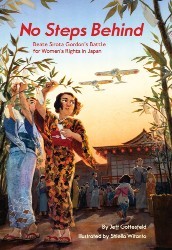The modern era has introduced many changes into the lives of Jewish women. Undoubtedly, one of the most notable was the Reform movement’s 1972 ordination of Sally Priesand as the first American female rabbi. As a token of our gratitude, we have the very Jewish obligation to teach children about her courageous persistence. Priesand did indeed open doors for those women, and men, who acknowledged the need for gender reform in traditional Jewish spaces. Fifty years later, Sandy Eisenberg Sasso and Margeaux Lucas have crafted an accessible introduction to Rabbi Priesand’s life, perfect for young readers who may not realize how firmly shut those doors once were.
While Lucas’s pictures capture the time period, they also depict a modernization that is central to Priesand’s quest. For instance, when she and a friend are conversing about the likely opposition to women in the rabbinate, their dark brown hair and mid-century fabric patterns stand out against the more generic congregants seated in front of them.
For Sasso’s part, much of the story relies on invented dialogue to advance the narrative. While each sentence accurately reflects the attitudes of the era, the cumulative effect is somewhat ideological. “I now know what I want to do. I want to be a rabbi … like you,” remarks one grateful young woman. Priesand’s skeptical friend, whose “jaw dropped” at the mere notion of female rabbis, warns her that no one will accept her aspirations: “Sally … look around! Women serve coffee, tea, and cake after services … they never take out the Torah.” There is no disputing the reality of these prejudices, but the characters who articulate them seem more like symbolic adversaries than real people.
Sally Opened Doors is effective in that it focuses on the most important parts of Priesand’s life, simplifying certain issues for young readers and maintaining the momentum of an exciting story. Yet some nuances are important. One visitor to Priesand’s synagogue rudely contends, “A woman rabbi? Outrageous! You start opening the door to change, and this is what happens.” Here it would be appropriate for Sasso to comment on the irony of his objection. Reform Judaism, after all, was predicated on a perceived need for change. Priesand’s main concern was not resistance to change in general, but the hypocrisy of those who opposed reform purely on the basis of gender.
Sasso and Lucas showcase a Priesand who refuses to let naysayers discourage her. Adults reading this book with children will have opportunities to discuss the limits imposed on women in the past and present, and to consider the ways in which a little bit of anger might be productive in the face of ongoing inequality. We are fortunate to have this new resource about a trailblazing Jewish feminist who would not take no for an answer.
Emily Schneider writes about literature, feminism, and culture for Tablet, The Forward, The Horn Book, and other publications, and writes about children’s books on her blog. She has a Ph.D. in Romance Languages and Literatures.





